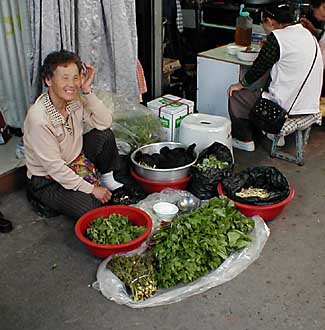

|
There are plenty of department stores in most medium to large Korean cities. Many of those cities are
also beginning to catch the urban sprawl virus, and building mega-markets (well, mega on a Korean scale,
where land is pricey) on the edges of the cities. So far, though, Korea's cities are far from dead. The streets and sidewalks are still mobbed with Koreans all day long (and often well into wee hours of the night). The old ways of doing business survive. You can still find traditional small shops, street vendors, and market stalls. Whatever you're looking for, it's probably there, from baskets of dried anchovies and squid and blocks of tofu to appliances, household goods, even plumbing fixtures. The photo above is a vegetable vendor in Kangnung's central market. About half a minute after I shot this picture, Margaret bought the bunch of "mountain vegetable" at the left front. (No, she doesn't know what its real name is. Sorry.) If you want to see this side of Korea, don't just sit there. Ten years from now it may be too late. This vendor is pretty typical - almost all of them are ajoma and halmoni (meaning middle-aged or elderly women), and so are the customers. Younger Koreans would rather work in an office than live this kind of life, and they'd rather shop in the stores than in the open or half-open market.
|